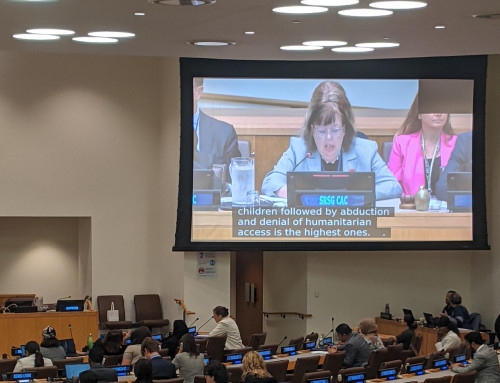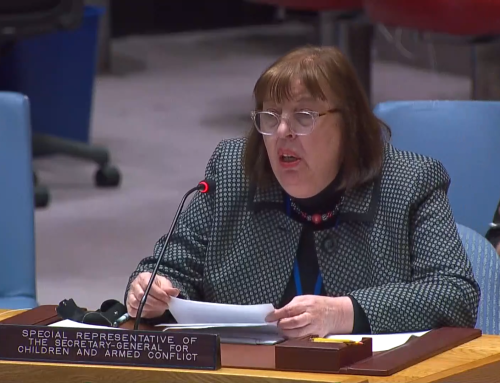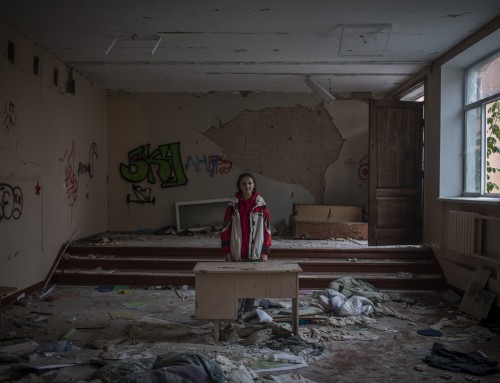Statement by SRSG Leila Zerrougui, SRSG for Children and Armed Conflict
Interactive Panel Discussion on the occasion of the Tenth Anniversary of SC Resolution 1612 (2015)
24 July 2015
What does resolution 1612 mean for children in armed conflict?
Excellences, Mesdames et Messieurs,
Je vous remercie de vous être joints à nous aujourd’hui pour célébrer le dixième anniversaire de la résolution 1612 adoptée par le Conseil de sécurité le 26 juillet 2005. Je suis honorée d’avoir à mes côtés dans le panel Leurs Excellences l’Ambassadeur de France et l’Ambassadeur de Malaisie. C’est également avec honneur que je salue les ambassadeurs présents malgré leurs agendas que je sais chargés. Enfin je remercie Mme Yoka Brandt, Directrice exécutive adjointe de l’UNICEF et Mr. Geert Cappelaere, Représentant de l’UNICEF au Soudan qui partageront avec nous leur perspective et expérience dans la mise en œuvre de la résolution 1612.
Comme vous le savez, la 1612 est la résolution fondatrice d’outils qui se sont révélés précieux au cours des dix dernières années dans la mise en œuvre du mandat sur les enfants et les conflits armés. Elle a créé un cadre de travail exceptionnel, fruit d’efforts de beaucoup d’entre vous, efforts qui continuent aujourd’hui encore.
The story of 1612 began six years before the resolution’s 2005 adoption when the Security Council, through resolution 1261, put in place the first building blocks in the framework to address violations of children and armed conflict. Resolution 1612 added the Monitoring and Reporting Mechanism as well as the Security Council Working Group. These tools ensure that information is timely, objective, accurate and reliable, and provide a clear focus for action and engagement. The resolutions since 1999 created a unique framework at a national and international level to help end grave violations against children.
Many Member States played a role in developing this evolving architecture. France and Benin were instrumental in the preparation of resolution 1612 and France was the first chair of the Working Group. I have the Ambassador of France next to me who can share his country’s experience. The Ambassador of Benin, who is in the audience, has first-hand knowledge of the discussions regarding 1612. Mexico, Germany, and Luxembourg also strengthened the framework as Working Group chairs. Her Excellency Ambassador Sylvie Lucas of Luxembourg is also with us today. I would like to thank her for her leadership as the previous chair of the Working Group and her continuing dedication to children and armed conflict. I hope she will say a few words on her experience during the discussion.
Most recently, the instrumental role of Malaysia, as Chair of the Working Group, in adding abduction as a trigger for listing in resolution 2225 contributed another important component. I would like to also acknowledge the strong partnerships built with regional organisations to implement this architecture.
As Special Representative, I must give particular credit to my predecessors, who each advanced the agenda in their own way. UNICEF also continues to provide vital backing to the framework at Headquarters and gathers information and engages with parties in all situations across the children and armed conflict mandate. DPKO and DPA, deserve significant recognition for their work in the field to implement the tools along with other partners such as UNHCR and OHCHR. Numerous NGOs had a major role in the framework’s implementation, and advocated to strengthen it to protect children. Without their efforts, this framework would not have had such an impact.
But, in tangible terms, what does resolution 1612 mean to children in situations of armed conflict? First, it is a framework to systematically monitor and report on the six grave violations against children to the Working Group. The Monitoring and Reporting Mechanism is now in place in 14 countries, and is a valuable tool to provide information to guide action and identify perpetrators.
Second, the architecture provided by the resolution created a platform to engage in constructive dialogue with parties to the conflict to address grave violations. The country task forces are co-chaired by the UNICEF representative and the highest United Nations representative in the field. This has brought increased attention of UN leadership on the ground to child protection concerns. But crucially, these task forces opened the space to engage with parties to conflict at the highest level. In many situations where the Monitoring and Reporting Mechanism has been in place, Governments have established inter-ministerial committees to interact with the country task force. This has galvanised actions and allowed progress to develop quickly due to the high-level engagement. Resolution 1612 also outlined the guiding principles of engagement with non-state armed groups in the context of the monitoring and reporting mechanism. UNICEF will be speaking in more detail on the operational side of the monitoring and reporting mechanism, including the opportunities and challenges at field level for engaging with parties to conflict.
Action plans are one clear example of the advantages of high-level engagement with parties to conflict. To date, 11 Government armed forces and 12 non-state armed groups have signed action plans with the UN. Nine parties to conflict have been delisted after implementing their action plan. More recently, the framework has been used in the context of the “Children, Not Soldiers” campaign, which aims to end child recruitment by Government forces. The architecture in place has allowed us to advance to a situation where 6 of the 8 Government forces listed for any of the six grave violations have signed actions plans with the United Nations. A number of them are making good progress towards delisting.
Third, 1612 provided an important opportunity to mainstream children and armed conflict in the work of the Security Council and other UN bodies. Today, the Security Council Working Group serves as a powerful advocate for advancing children’s rights in time of armed conflict and is supported by the framework in place. Malaysia, as current Chair, will speak on the opportunities and challenges for the Working Group.
Despite this progress, we face challenges in implementing the framework in light of the changing nature of conflict in the 10 years since 1612’s adoption. I will briefly outline these challenges and hope they provide points for discussion in the latter part of this event.
One important issue we face is the regional aspect of conflict. For instance, how can we monitor violations when groups operate across national borders? These issues have arisen previously with the Lord’s Resistance Army, but they are reoccurring with the increase in violations by ISIL and Boko Haram.
On a practical level, another test we face is the capacity to be ready to engage a party to conflict, particularly non-state armed groups, when an opportunity arises. Non-state armed groups vary vastly and it is difficult to have all the tailor-made tools ready to go when an opportunity to engage arises, such as in a peace process.
Lastly, it is a challenge to further support national institutions and address root causes of grave violations. For instance, in many situations where the monitoring and reporting mechanism is in place, judicial systems are not always fully functioning. We must work with Governments to build support for strong institutions to help end impunity for grave violations against children.
Excellencies, Ladies and Gentlemen,
Thank you very much for your attention. I will leave you with those remarks for our further reflection and pass over to His Excellency, Mr François Delattre. I hope we will have a fruitful and energetic discussion later.





